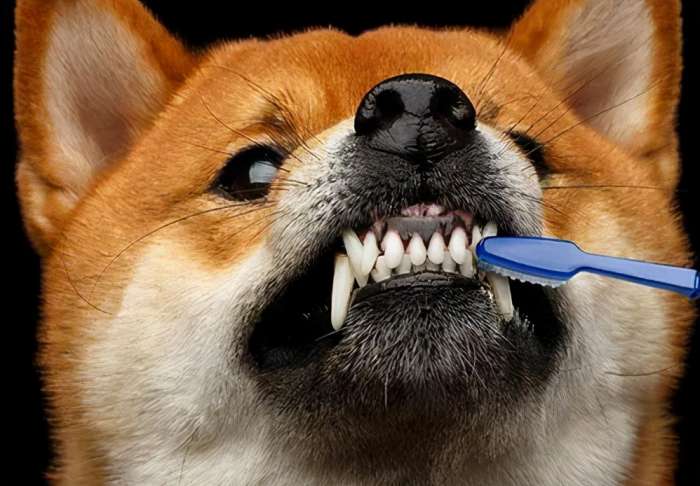Maintaining your dog’s dental health is crucial for their overall well-being. Just like humans, dogs can suffer from dental issues if their teeth are not properly cared for. One of the key components of effective dental care is choosing the right toothbrush and toothpaste for your furry friend. This article will guide you through the selection process, ensuring your dog’s teeth stay clean and healthy.

1. The Importance of Dental Care for Dogs
Why Dental Health Matters
Dental health is often overlooked by dog owners, but it plays a significant role in your pet’s overall health. Poor dental hygiene can lead to:
- Periodontal Disease: An infection of the gums that can cause tooth loss and affect your dog’s internal organs.
- Pain and Discomfort: Dental issues can lead to pain, making it difficult for your dog to eat or play.
- Bad Breath: This can be a sign of underlying dental problems.
Recognizing the Need for Dental Care
As a responsible dog owner, it’s essential to regularly check your dog’s mouth for signs of dental issues, such as:
- Red or swollen gums
- Loose teeth
- Bad breath
- Excessive drooling
2. Choosing the Right Toothbrush for Your Dog
2.1. Types of Dog Toothbrushes
Manual vs. Electric Toothbrushes
When selecting a toothbrush for your dog, you have two primary options: manual and electric.
- Manual Toothbrushes: These are the most common and come in various sizes and shapes. Look for brushes designed specifically for dogs, which often have softer bristles to prevent gum damage.
- Electric Toothbrushes: These can make brushing easier and more effective due to their rapid movement. Ensure that the electric toothbrush is designed for pets, as those made for humans may not be suitable.
2.2. Size Matters
Choosing the Right Size
Select a toothbrush that is appropriate for your dog’s size. Smaller breeds may require a smaller toothbrush head to navigate their mouths easily, while larger breeds can handle larger brushes.
2.3. Handle Design
Ergonomic Features
Look for a toothbrush with an ergonomic handle that is comfortable for you to hold. This will make the brushing process easier and more effective.
3. Selecting the Right Toothpaste for Your Dog
3.1. Dog-Specific Toothpaste
Why Not Human Toothpaste?
Never use human toothpaste on dogs, as it often contains ingredients that can be toxic to pets, such as xylitol. Always choose toothpaste specifically formulated for dogs.
3.2. Flavors and Preferences
Choose What Your Dog Likes
Dog toothpaste comes in various flavors, including poultry, beef, and peanut butter. Selecting a flavor your dog enjoys will make the brushing experience more pleasant for both of you.
3.3. Ingredients to Look For
Safe and Effective Ingredients
Look for toothpaste that contains safe and effective ingredients. Some beneficial ingredients include:
- Enzymes: Help break down plaque and food particles.
- Baking Soda: Provides natural cleaning properties.
- Natural Ingredients: Avoid artificial additives and chemicals.
4. Tips for Effective Brushing
4.1. Establish a Routine
Regular Brushing Schedule
Create a routine for brushing your dog’s teeth. Aim to brush at least two to three times a week, if not daily. Consistency is key to maintaining good dental health.
4.2. Make It a Positive Experience
Use Positive Reinforcement
Introduce your dog to brushing gradually. Start by allowing them to taste the toothpaste, then gently introduce the toothbrush. Always reward your dog with praise or a treat after brushing to create a positive association.
4.3. Be Gentle
Avoid Harm
When brushing, use gentle circular motions, and be cautious around sensitive areas like the gums. If your dog shows signs of discomfort, take a break and try again later.
5. Alternative Dental Care Products
5.1. Dental Chews
Incorporating Dental Chews
Consider incorporating dental chews into your dog’s routine. These can help reduce plaque and tartar while providing a fun chewing experience.
5.2. Water Additives
Dental Health in Their Water
Some products can be added to your dog’s water to help promote dental health. These additives can reduce plaque and freshen breath.
5.3. Professional Cleanings
Importance of Vet Check-ups
Regular veterinary check-ups and professional dental cleanings are essential for maintaining your dog’s dental health. Discuss your dog’s dental needs with your veterinarian.
6. Understanding Your Dog’s Unique Needs
6.1. Age Considerations
Tailoring Dental Care for Different Ages
Puppies, adult dogs, and seniors have different dental care needs. Puppies may require softer brushes, while older dogs may benefit from special dental products to address age-related issues.
6.2. Breed-Specific Considerations
Recognizing Breed Differences
Certain breeds are more prone to dental issues, such as small breeds that may have overcrowded teeth. Tailor your dental care approach based on your dog’s breed.
Conclusion
Choosing the right toothbrush and toothpaste for your dog is vital for their dental health. By understanding your options and establishing a regular dental care routine, you can help prevent dental issues and ensure your dog maintains a healthy smile. Always consult with your veterinarian to tailor your approach to your dog’s specific needs.

Comments (0)